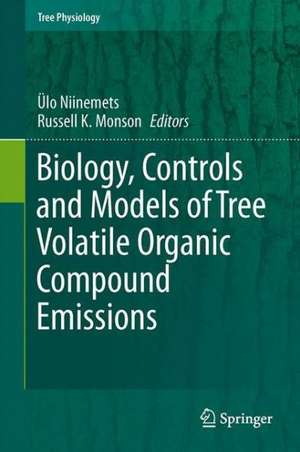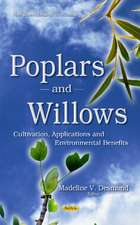Biology, Controls and Models of Tree Volatile Organic Compound Emissions: Tree Physiology, cartea 5
Editat de Ülo Niinemets, Russell K. Monsonen Limba Engleză Hardback – 19 iul 2013
Written by leading experts in the field, the focus is on recent advancements in understanding the controls on plant-driven BVOC emissions, including efforts to quantitatively predict emissions using computer models, particularly on elicitation of emissions under biotic and abiotic stresses, molecular mechanisms of volatile synthesis and emission and the role of emissions in plant stress tolerance.
| Toate formatele și edițiile | Preț | Express |
|---|---|---|
| Paperback (1) | 957.13 lei 6-8 săpt. | |
| SPRINGER NETHERLANDS – 6 aug 2015 | 957.13 lei 6-8 săpt. | |
| Hardback (1) | 972.62 lei 6-8 săpt. | |
| SPRINGER NETHERLANDS – 19 iul 2013 | 972.62 lei 6-8 săpt. |
Preț: 972.62 lei
Preț vechi: 1186.12 lei
-18% Nou
Puncte Express: 1459
Preț estimativ în valută:
186.11€ • 194.86$ • 154.37£
186.11€ • 194.86$ • 154.37£
Carte tipărită la comandă
Livrare economică 09-23 aprilie
Preluare comenzi: 021 569.72.76
Specificații
ISBN-13: 9789400766051
ISBN-10: 940076605X
Pagini: 400
Ilustrații: XV, 547 p.
Dimensiuni: 155 x 235 x 27 mm
Greutate: 1.23 kg
Ediția:2013
Editura: SPRINGER NETHERLANDS
Colecția Springer
Seria Tree Physiology
Locul publicării:Dordrecht, Netherlands
ISBN-10: 940076605X
Pagini: 400
Ilustrații: XV, 547 p.
Dimensiuni: 155 x 235 x 27 mm
Greutate: 1.23 kg
Ediția:2013
Editura: SPRINGER NETHERLANDS
Colecția Springer
Seria Tree Physiology
Locul publicării:Dordrecht, Netherlands
Public țintă
ResearchCuprins
Preface.- Chapter 1 Diversification of Volatile Isoprenoid Emissions from Trees: Evolutionary and Ecological Perspectives.- Chapter 2 BVOC Mediated Plant-Herbivore Interactions.- Chapter 3 The Biochemistry and Molecular Biology of Volatile Messengers in Trees.- Chapter 4 Genetic Engineering of BVOC Emissions from Trees.- Chapter 5 Molecular and Pathway Controls on Biogenic Volatile Organic Compound Emissions.- Chapter 6 Metabolic and Gene Expression Controls on the Production of Biogenic Volatile Organic Compounds.- Chapter 7 The Roles of Stomatal Conductance and Compound Volatility in Controlling the Emission of Volatile Organic Compounds from Leaves.- Chapter 8 The Role of Volatile Organic Compounds in Plant Resistance to Abiotic Stresses: Responses and Mechanisms.- Chapter 9 Flooding-driven emissions from trees.- Chapter 10 Modification of BVOC Emissions by Changes in Atmospheric [CO2] and Air Pollution.- Chapter 11 Multitrophic Signalling in Polluted Atmospheres.- Chapter 12 Leaf-Level Models of Constitutive and Stress-Driven Volatile Organic Compound Emissions.- Chapter 13 Scaling BVOC Emissions from Leaf to Canopy and Landscape: How Different Are Predictions Based on Contrasting Emission Algorithms?.- Chapter 14 Upscaling Biogenic Volatile Compound Emissions from Leaves to Landscapes.- Chapter 15 Scaling Emissions from Agroforestry Plantations and Urban Habitats.- Chapter 16 Global Modeling of Volatile Organic Compound Emissions.- Chapter 17 Climate Feedbacks Linking the Increasing Atmospheric CO2 Concentration, BVOC Emissions, Aerosols and Clouds in Forest Ecosystems.- Chapter 18 State-of-the-art of BVOC research: what do we have and what have we missed? A Synthesis.
Textul de pe ultima copertă
The book deals with a highly relevant interdisciplinary topic: tree-atmosphere interactions. Plant-driven volatile organic compound (BVOC) emissions play a major role in atmospheric chemistry, including ozone and photochemical smog formation in the troposphere, and they extend the atmospheric lifetime of the key greenhouse gas, methane. Furthermore, condensation of photo-oxidation products of BVOCs leads to formation of secondary organic aerosols with profound implications for the earth's solar radiation budget and climate. Trees represent the plant life form that most contributes to BVOC emissions, which gives global forests a unique role in regulating atmospheric chemistry.
This book, written by leading experts in the field, focuses on recent advancements in understanding the controls on plant-driven BVOC emissions, including efforts to quantitatively predict emissions using computer models. Particular emphasis is on elicitation of emissions under biotic and abiotic stresses, molecular mechanisms of volatile synthesis and emission and the role of emissions in plant stress tolerance. Potentials and limitations of genetic engineering of volatile emissions are also covered. This book addresses all biological scales of organization from molecules to globe and makes a major leap in summarizing and synthesizing the existing information.
The main goal of the book is to provide state-of-the-art summary of the exciting field of tree volatile emissions and offer a perspective for future investigations. The book is intended to serve as an invaluable resource for graduate students starting a thesis project on tree volatile emissions as well as serves as a contemporary source of reference for teachers, scientists and professional within and outside the exciting field of plant-driven volatile emissions.
This book, written by leading experts in the field, focuses on recent advancements in understanding the controls on plant-driven BVOC emissions, including efforts to quantitatively predict emissions using computer models. Particular emphasis is on elicitation of emissions under biotic and abiotic stresses, molecular mechanisms of volatile synthesis and emission and the role of emissions in plant stress tolerance. Potentials and limitations of genetic engineering of volatile emissions are also covered. This book addresses all biological scales of organization from molecules to globe and makes a major leap in summarizing and synthesizing the existing information.
The main goal of the book is to provide state-of-the-art summary of the exciting field of tree volatile emissions and offer a perspective for future investigations. The book is intended to serve as an invaluable resource for graduate students starting a thesis project on tree volatile emissions as well as serves as a contemporary source of reference for teachers, scientists and professional within and outside the exciting field of plant-driven volatile emissions.
Caracteristici
A Highly relevant interdisciplinary topic: tree-atmosphere interactions, focusing on the recent advancements in understanding the controls on plant-driven volatile organic compound emission fluxes and on the quantitative prediction of these fluxes by models Unique title in the market Contributions from leading experts in the field This volume addresses a wide audience including graduate students, teachers, scientists and professionals dealing with forestry, terrestrial ecology, plant biology, environmental science and biosphere-atmosphere interactions


















